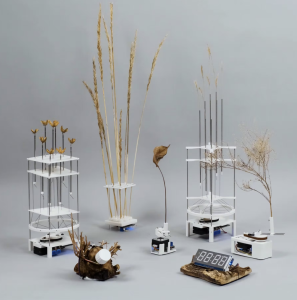The Human-Nature Ecosystem
By Alihelmael Avilés Sánchez
Are technology and nature becoming part of the same ecosystem? As human technological prowess continues to increase, so does our effect on nature. In a way, technology and industry have intertwined with nature to become part of one grandiose ecosystem. Consequently, humanity’s effect on climate change and the environment has become increasingly impactful over time. When entering the CoLab Studio, you will see a set of vases and sculptures that gyrate almost as if they were in choreography with each other. When taking a deeper look at these sculptures, they give us a better understanding of how nature has been affected by human interference over time, and how humanity’s technological development has become intertwined with our environment: “feeling climate crisis.”

“Feeling Climate Crisis” is a set of kinetic structures designed and made by Boston-based artist Gaurav Patekar. Using components manufactured from 3D printers, laser cutting, and other building techniques, Gaurav Patekar was able to develop a set of sculptures that visualize different aspects of the climate crisis through a series of kinetic patterns that change over time. Each sculpture is composed of two key components: a natural component and an electro-mechanical component. The two components together represent the intersection between the natural world and the human world (industrial and technological world). The sculptures also move at different rates over time. The movement of each sculpture represents a different set of climate data. The movement rate of each sculpture represents different climate change indicators, which vary with respect to time from the year 1990 up until 2020. However, out of all the information that one can get from this exhibit, the aspect that I found the most interesting is how the sculptures try to mimic the behavior of nature.
Humanity has a unique affinity with nature, which is often referred to as biophilia. However, over the years, due to many factors, such as urbanization and climate change, we humans have distanced ourselves from the natural experience, instead opting for technology to satiate what once nature was able to fulfill in the past. The sad truth is that, over time, access to real nature will become more scarce.
Is technology truly able to replace nature? Well, research suggests that nature-like technology might be more beneficial in terms of psychological well-being and cognitive development than no interaction at all, but not better than experiencing real nature. In the same way that the sculptures from “Feeling Climate Crisis” only mimic the behavior of nature, technology falls short when trying to fulfill our need for nature.
About the Author:
Alihelmael Avilés
 Alihelmael Avilés Sánchez is an undergraduate electrical engineering student at Michigan State University. His areas of interest include physics, technology, and business.
Alihelmael Avilés Sánchez is an undergraduate electrical engineering student at Michigan State University. His areas of interest include physics, technology, and business.